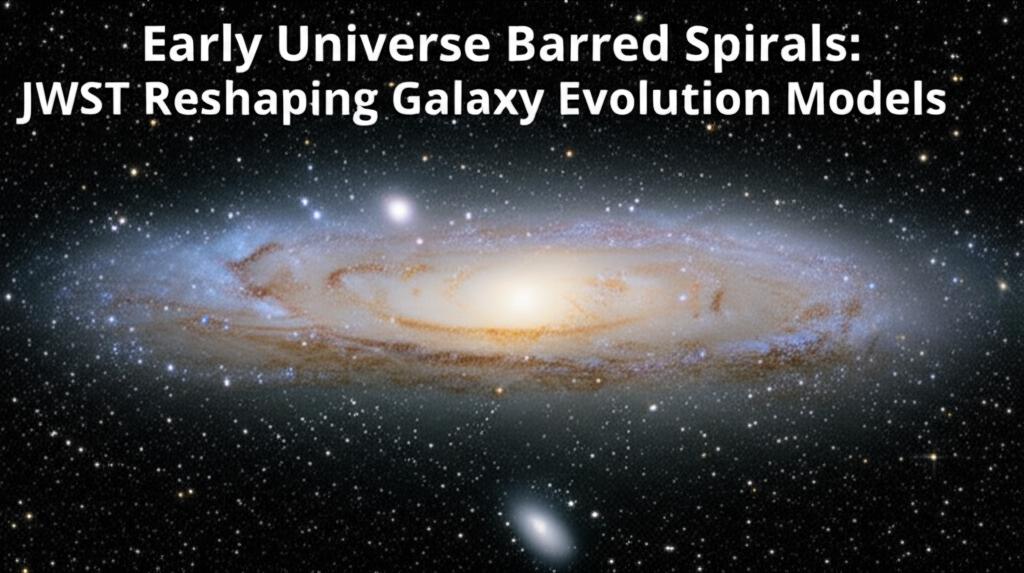The cosmos just got a lot more interesting, and our understanding of how galaxies like our own Milky Way came to be is undergoing a dramatic rewrite. The culprit? The James Webb Space Telescope (JWST), which is peering back into the dawn of time and discovering that majestic barred spiral galaxies were already in place far earlier than astronomers ever thought possible.
For decades, the prevailing wisdom was that the early universe was a chaotic place, filled with clumpy, irregular young galaxies. Complex structures like the distinct central bars and sweeping spiral arms seen in many mature galaxies today were believed to have formed much later, after billions of years of cosmic evolution. Barred spirals, in particular, with their elongated central structures of stars, were thought to be a relatively recent cosmic development.
Enter JWST. With its unprecedented infrared sensitivity, this powerful new observatory is "pulling back the curtain" on the early universe, revealing surprisingly mature galaxies with well-defined bars when the universe was just a fraction of its current age – in some cases, only 2 to 3 billion years after the Big Bang.
A Galactic Surprise PartyRecent studies using JWST data have identified a significantly higher number of barred spiral galaxies in the early universe than previously detected by telescopes like Hubble. One study revealed bar formation in galaxies seen as they were between 8 billion and 11.5 billion years ago. Out of 368 disk galaxies considered, a remarkable 20% already possessed bars – double the number observed by Hubble in similar cosmic epochs. Another groundbreaking discovery unveiled a barred spiral galaxy, ceers-2112, existing when the universe was merely 15% of its current age, about 11.7 billion years ago.
These findings are "a real surprise," according to astronomers, because the early universe was expected to be too turbulent, with frequent galaxy collisions and vast amounts of unformed gas, to support the stable conditions needed for bars to form. Bars are significant because they are a sign that a galaxy has reached a more settled, mature phase. They play a crucial role in galaxy evolution by funneling gas towards the galactic center, which fuels star formation and can help grow supermassive black holes.
Rewriting the Cosmic TimelineThe presence of these early bars forces a major rethink of galaxy evolution models. Current theories predicted that the physical and dynamical conditions in the early universe were simply not conducive to bar formation. The fact that JWST is finding so many, so early, suggests that the processes driving galaxy maturation can happen much faster than previously understood.
Astronomers are now grappling with how these massive, ordered structures could assemble so quickly. Some theories suggest that the amount of dark matter influencing bar formation in the early universe might need adjustment. Others propose that bars might form spontaneously in gas-rich, rotationally-dominated disks, without the need for external triggers like galaxy mergers, which were thought to be more prevalent in the turbulent early cosmos.
Monster Barred Spirals Throw Another Wrench in the WorksAdding another layer to this evolving picture, JWST, in conjunction with observatories like ALMA, has also uncovered "monster" barred spiral galaxies in the early universe. One such galaxy, J0107a, observed as it was 11.1 billion years ago, is exceptionally massive – more than ten times the mass of the Milky Way – and boasts a star formation rate about 300 times higher.
Intriguingly, while the bar structure and gas distribution in J0107a show similarities to modern barred spirals, the concentration of gas in its bar is significantly higher, and the gas flows much faster. This massive influx of gas is believed to be fueling its intense starburst activity, providing new clues about how these "monster" galaxies evolve and potentially challenging assumptions that such intense star formation was solely due to galaxy collisions.
A New Era of DiscoveryThe James Webb Space Telescope is not just showing us more distant galaxies; it's revealing a universe that is more structured, more mature, and evolving more rapidly in its youth than we ever imagined. The discovery of early barred spirals is a testament to JWST's transformative power, forcing astronomers back to the drawing board to refine their understanding of how galaxies, including our own, came to be. As more data pours in from this incredible observatory, we can expect further surprises and an unprecedented transformation in our knowledge of cosmic evolution. The universe, it seems, grew up fast.

